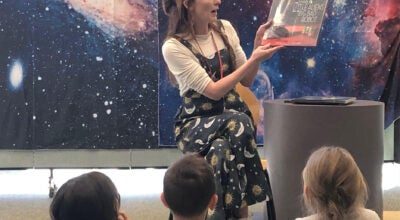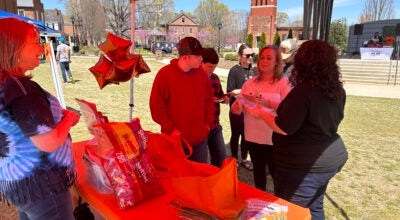At NCRC, a year of milestones
Published 12:00 am Wednesday, January 9, 2013
KANNAPOLIS – The North Carolina Research Campus, the biotechnology research hub in downtown Kannapolis, opened on the brink of what many call the “Great Recession.”
But though growth has been slower than many would have liked, Director Mary Ann Lila of the N.C. State University Plants for Human Health Institute said there were many milestones at the NCRC in 2012, and more to come.
“We have all the enthusiasm, all the bells and whistles,” Lila said, “and then, economic crisis.”
Not far from her office windows, the Core Lab complex at the heart of the campus houses cutting-edge facilities and equipment used by universities and private companies alike.
Some of those labs and offices are still vacant, awaiting future clients.
But promising discoveries at the NCRC made headlines worldwide in 2012, and Lila (among others) expects still more in 2013.
From a BBC interview with David Nieman, director of Appalachian State University’s Human Performance Lab, on the health effects of chia seeds, to studies on potential health benefits from blueberries and other foods coming from Lila’s labs, research from the NCRC is being noticed.
Eight public and private universities and a range of health agencies and corporations are partners at the NCRC.
Throughout 2012, they announced a wide range of studies and some new products based on research conducted in Kannapolis.
Last week, the NCRC announced findings from studies on fatty liver disease, or FLD.
Alcohol abuse, obesity and other health problems are connected to FLD.
The disorder can lead to cirrhosis of the liver and cancer, among other health problems.
According to a report put out by the NCRC, Zhanxiang Zhou – co-director of the UNC Greensboro Center for Translational Biomedical Research at the campus – learned during a visit to China that some people he knew had been diagnosed with alcohol-related FLD.
Zhou was quoted as saying he hopes to develop FLD therapies by examining how diet and the body’s internal mechanisms impact the disease’s development.
And, in studies using animals, Zhou has found that zinc supplements may prevent and reverse FLD-related liver damage.
Other scientists may be help solve a nutrition crisis in Africa.
In one of the Plants for Human Health Institute “wet labs” at the NCRC, researchers are studying how nutrients in fruits and vegetables can be stabilized for long-term storage.
In the southern African nation of Zambia, Lila said, malnutrition is a serious problem.
But, she said, a project supported by the Bill & Melinda Gates Foundation may change that.
Ivette Guzman, a postdoctoral research associate who works with Lila, has been working at the NCRC since 2010.
She picks up a tray of vials filled with brightly-colored liquids – oils that contain nutrients captured from carrots, mangoes, kale and other foods.
“We’re trying to develop a functional food for Zambia,” Guzman said.
Six months out of the year, she said, there aren’t any fresh fruits and vegetables. With only sporadic electricity in some area, there aren’t easy ways to preserve those foods.
The foods available the rest of the year, such as corn grits, lack essential vitamins and nutrients, she said.
As a result, she said, the children’s growth is stunted, and many Zambians suffer poor health.
Guzman and other researchers hope to create shelf-stable food products with the nutrition of those fruits and vegetables.
“We extract (nutrition) from the plant tissue, and capture it,” she said, “either in oil or in flour, capturing these compounds.”
“We’re actually able to make simple cereals that capture all the nutrients of the mango … and have the protective properties,” Guzman said.
The goal, she said, is not to change the Zambians’ diet, but to enrich the foods they already have – so they can get the same nutrition from corn grits that they would get in fruits and vegetables.
Since the project began in October, Lila said, researchers have already made progress in discovering techniques that, one day, villagers might be able to use themselves with simple technology.
Lila hopes that these techniques, if successful, might be expanded into Uganda and Kenya as well.
“That’s probably my favorite and most promising project right now,” Lila said.
In addition to university research, Dole Foods – owned by David Murdock, who developed the campus – and other NCRC partner companies, such as General Mills and Monsanto, are conducting research in Kannapolis.
While the economy has slowed the pace of development, one proposal in the works for 2013 may bring more researchers on board.
The Plant Pathways Elucidation Project is a plan to recruit students who are working on their doctoral degrees, teaming them up with industry scientists.
According to a summary of the proposal, the effort would be aimed at helping future researchers have access to the technology and facilities of the NCRC.
At the same time, four-year college students from around the area would have opportunities to gain research experience.
Lila said the project would help fill a growing demand for experience. Competitive graduate programs are looking for college students with experience.
Lila said researchers at the NCRC are getting calls from students looking for internships, but there aren’t enough to meet the demand. “They’re begging to get in,” she said.
The project would also help fill some of those facilities in the Core Lab that are still waiting for clients.
“We want to populate them, we want to get the instrumentation in place rapidly,” Lila said.
The goal of the project would be to help discover how plants can lead to new products, new medical breakthroughs and more.
“Plants are better chemists than any human being could ever be,” Lila said.
And, she said, by building “mega-teams” of student researchers and experts, more progress can be made toward discovering how they work.
“This is not ivory tower science,” she said. “The questions that are being asked are being asked by Dole, by Monsanto. It’s all interdisciplinary.”
For UNC Charlotte graduate student Jon Shea, currently a research technician at the NCRC, the experience is already leading to opportunities.
He’s a student in bioinformatics – the science of how biological data, such as proteins or genes, can be analyzed.
“Right now, I’m working on the blueberry project,” Shea said.
His lab computer terminal, surrounded by papers and binders, shows data from a study of over 1,100 different blueberry plants.
The study hopes to find which varieties of blueberries have the most nutrition.
One day, Shea said, this study might impact what kinds of blueberries are sold at grocery stores, or used in making products.
“My goal would be for farmers to have the best plants to grow,” Shea said.
He said he’s excited about the experience he’s gained at the NCRC, and looks forward to putting it to use at UNCC.
If 2013 goes as expected, he may be joined by many more students whose scientific careers began in Kannapolis.
Contact Hugh Fisher via the editor’s desk at 704-797-4244.





